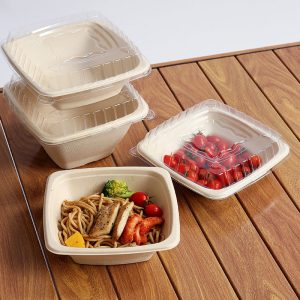This article explores why the airline catering industry is shifting from plastic to biodegradable tableware. It examines regulatory pressures, passenger demand for sustainability, and innovations in eco-friendly packaging, highlighting how biodegradable trays, cutlery, and meal boxes are shaping the future of in-flight and railway catering.
1. Introduction
In modern transportation, both aviation and railways serve as essential modes of travel, carrying millions of passengers daily. Alongside the journeys comes the demand for onboard catering—whether it is full meals on long-haul flights or bento boxes and beverages on high-speed trains. Packaging plays a central role in this process. However, with the growing global concern over plastic pollution, traditional single-use plastic tableware has increasingly revealed its environmental shortcomings.
In recent years, international regulations, advocacy by environmental organizations, and rising consumer awareness of sustainability have collectively accelerated the transformation of catering services toward eco-friendly practices. Among them, airline catering—highly globalized by nature—has become the frontrunner in adopting biodegradable tableware. Railway catering, though influenced by similar trends, has transitioned more slowly.
This article explores why airlines are quicker than railways to adopt biodegradable alternatives, the role of policies and regulations, and how suppliers such as DASHAN provide viable eco-friendly packaging solutions through cornstarch, bagasse, and PLA materials.
2. Challenges in Airline Catering Packaging
- Heavy reliance on plastics
For decades, airline catering has depended on single-use plastic products: trays, cutlery, cups, straws, and wrappers. These items are typically used for just a few hours during a flight before being discarded. On a single international flight, hundreds of kilograms of plastic waste may be generated. Industry estimates suggest that aviation alone produces over 5 million tons of plastic waste annually, much of it from catering packaging. - Environmental and compliance pressures
Because flights cross international borders, waste handling is subject to complex regulations. Some countries prohibit airline waste from being landfilled or incinerated domestically, forcing carriers to dispose of it at the departure airport. This not only raises disposal costs but also magnifies the environmental burden of plastic. As passengers increasingly demand greener practices, airlines are compelled to find alternatives.
3. Policy and Regulatory Drivers
- EU Single-Use Plastics Directive (SUP Directive)
Since 2021, the EU has enforced the SUP Directive, banning sales and use of single-use plastic cutlery, plates, straws, and stirrers. This directly impacts all airlines operating within Europe, requiring them to accelerate their switch to biodegradable packaging. - International Aviation Initiatives
The International Air Transport Association (IATA) and the International Civil Aviation Organization (ICAO) have committed to “Net Zero by 2050.” Beyond fuels and operations, catering packaging is included in sustainability strategies, pushing airlines to adopt greener practices. - National and regional regulations
- Spain: strict restrictions on single-use plastics in the foodservice sector, mandating compostable or recyclable packaging.
- France: bans single-use plastic tableware for dine-in foodservice.
These regulations shape not only airlines but also rail operators, though the latter face less direct international compliance pressure.
4. Why Airlines Move Faster
- Brand and passenger experience
In a highly competitive global market, sustainability is a brand differentiator. Many travelers, particularly younger generations, favor airlines with strong environmental commitments. Biodegradable tableware reduces pollution and enhances the perception of a “green flight.” - Centralized supply chains
Airlines typically source catering through centralized contracts with major providers such as LSG Sky Chefs or Gate Gourmet. This structure enables swift standardization when switching from plastic to biodegradable alternatives. - International compliance and reputation
Airlines, by their cross-border nature, must adhere to multiple jurisdictions’ environmental standards. Rail catering, in contrast, is usually domestic, facing fewer external mandates.
5. Railway vs. Airline Catering
Key differences include:
- Regulation intensity: Airlines must follow international rules, while railways primarily comply with domestic ones.
- Passenger demographics: Rail passengers, often short- or mid-distance travelers, show lower awareness of packaging sustainability.
- Transition speed: Railways are gradually adopting bagasse trays and PLA cups but lack the strong external push faced by airlines.
Nevertheless, in regions with advanced rail networks—such as Europe and China—railway catering is increasingly adopting biodegradable solutions, aligning with aviation’s long-term trajectory.
6. Biodegradable Tableware Solutions
- Main material categories
- Cornstarch tableware: made from renewable starch, compostable and non-toxic.
- Bagasse products: derived from sugarcane fiber byproducts, lightweight, heat-resistant, and ideal for trays and meal boxes.
- PLA cups and cutlery: bioplastic with high clarity, commonly used for beverage service.
- Advantages and limitations
- Cornstarch: strong eco-profile but limited heat resistance.
- Bagasse: microwaveable and freezer-safe, versatile in catering.
- PLA: aesthetically close to traditional plastic but requires industrial composting for degradation.
- DASHAN’s eco-friendly offerings
As a global supplier, DASHAN delivers:
- Cornstarch cutlery sets suitable for airline meal trays.

- Bagasse meal boxes and trays that replace plastic containers with compostable alternatives.

- PLA cups and lids for cold beverages.

DASHAN’s solutions comply with EU and international environmental regulations, offering scalable replacements for aviation and railway catering.
7. Future Trends and Challenges
- Material innovation
Emerging composites, such as bio-coated paper trays, combine durability with environmental benefits. - Cost and scalability
Biodegradable tableware is still more expensive than plastic. Achieving cost parity requires mass production and policy support. - Collaboration and policy support
Governments, transport operators, and suppliers must collaborate to establish a circular and sustainable catering ecosystem.
8. Conclusion
Airline catering’s faster adoption of biodegradable tableware is driven by regulatory pressure, global operations, brand value, and centralized supply chains. While railway catering is transitioning more slowly, it too is influenced by policies and consumer demand, pointing toward an inevitable shift.
Throughout this transition, DASHAN’s cornstarch, bagasse, and PLA-based solutions offer practical, compliant, and scalable alternatives. Together, aviation and rail catering are moving from the “plastic era” to the “biodegradable era,” reshaping the future of sustainable travel dining.
FAQ
1. Why are airlines switching to biodegradable tableware?
Airlines are adopting biodegradable options to meet environmental regulations, reduce plastic waste, and appeal to eco-conscious passengers.
2. What types of biodegradable products are used in airline catering?
Common items include compostable trays, cutlery, meal boxes, and cups made from bagasse, PLA, and cornstarch materials.
3. Are biodegradable tableware items safe for hot meals served in-flight?
Yes, materials like bagasse and CPLA are heat-resistant and designed to safely handle hot, oily, and saucy foods.
4. How do biodegradable solutions benefit airline operations?
They reduce environmental impact, enhance brand reputation, and align with sustainability goals without compromising food safety.
5. Are railway catering services adopting the same practices?
Yes, rail operators in many regions are also turning to biodegradable packaging to meet passenger expectations and comply with sustainability policies.
References
- International Air Transport Association (IATA). Sustainability in Aviation: Reducing Single-Use Plastics. https://www.iata.org/en/programs/environment/sustainable-aviation/
- European Union. Directive on Single-Use Plastics (SUP Directive). https://environment.ec.europa.eu/topics/plastics/single-use-plastics_en
- ICAO (International Civil Aviation Organization). Aviation and the Circular Economy. https://www.icao.int/environmental-protection/Pages/default.aspx
- Railway Gazette International. Rail Catering Goes Green with Compostable Packaging. https://www.railwaygazette.com/
- European Bioplastics. Bioplastics Market Data 2024. https://www.european-bioplastics.org/market/




